April 14 - 20, 2013: Issue
106
HMS Bounty Wooden Model Ship
Wooden ship models or wooden model ships are scale representations of ships, constructed mainly of wood. This type of model has been built for over two thousand years. Ancient ship and boat models have been discovered throughout the Mediterranean, especially from ancient Greece, Egypt, and Phoenicia. Archaeologists have determined that Ancient Greek ship models were used as burial or votive offerings and as household articles such as lamps or drinking vessels or even children’s toys. The kinds of ships depicted in Ancient Greek models can be classified broadly as small craft, merchant vessels, and warships. Models were cast in different materials, including wood, bronze, lead, and clay.
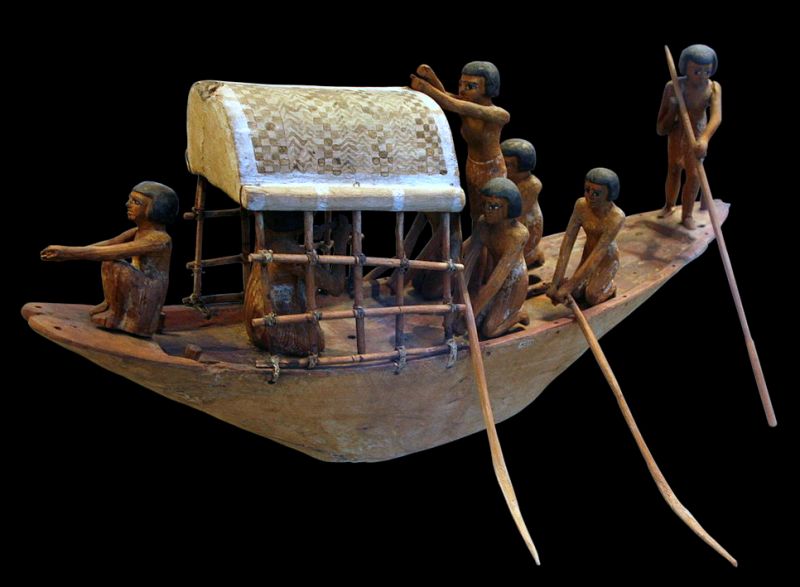
Model ship from a tomb, Ancient Egypt, c. 2000 BCE.
Some of the oldest surviving European ship models have been those of early craft such as galleys, galleons, and possibly carracks, dating from the 12th through the 15th centuries and found occasionally mounted in churches, where they were used in ceremonies to bless ships and those who sailed in them, or as votive offerings for successful voyages or surviving peril at sea, a practice which remained common in Catholic countries until the 19th century.
Until the early 18th century, virtually all European small craft and many larger vessels were built without formal plans being drawn. Shipwrights would construct models to show prospective customers how the full size ship would appear and to illustrate advanced building techniques. These were also useful for marine artists, and it is clear that from Dutch Golden Age Painting onwards extensive use of models was made by artists.
Ship models constructed for the Royal Navy were referred to as Admiralty models and were principally constructed during the 18th and 19th centuries to depict proposed warship design. Although many of these models did not illustrate the actual timbering or framing, they did show the form of the hull and usually had great detail of the deck furnishings, masts, spars, and general configuration. Some of these grand models were decorated with carvings of great beauty and were evidently constructed by teams of artisans.
Admiralty style ship models were built by ship builders from the 15th to the 19th century. They served as a design aid for the engineers, a simulator for those responsible for operating the vessel and as a "show and tell" display to be used for those raising funds from investors. An Admiralty model will have some parts of it un-planked exposing the framing and internal and deck furnishings. Usually masts, spars and some rigging are in place. The keel, stern post and stem are erected and the ribs are attached to the keel. This will then represent the general form of the hull. Some of the planks are then applied to the ribbed frame. In some Admiralty boat models the entire hull will be planked while only a portion of the deck will be planked. In other models, a side of the hull will be left un-planked while the deck is planked. Another version will have the entire hull un-planked while the deck is planked. An Admiralty style model could also be a cross section of the hull. This is where all the planking is in place however the model would only represent part of the ship such as the bow, mid section or stern. (1.)
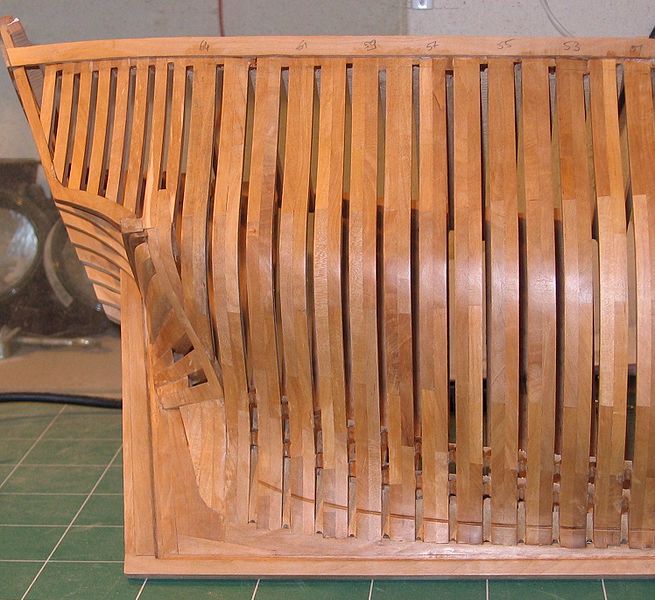 Admiralty models were also utilised to avoid construction errors that
might have evolved as the ship itself took form. To left is an example of an
Admiralty model illustrating the frames of a ship.
Admiralty models were also utilised to avoid construction errors that
might have evolved as the ship itself took form. To left is an example of an
Admiralty model illustrating the frames of a ship.
Model ships today range in size from 1/6000 scale wargaming miniatures to large vessels capable of holding people. The one shown here is a minature of the HMS Bounty and a favourite among many Australians due to its historical significance and links to Australia.
There are five basic types of construction used in building a
wooden ship model hull:
Solid wood hull sawn and carved from a single block
of wood. Gluing together two thinner blocks of wood so that a block is formed
with the seam vertical, so that the seam will show running down that surface of
the block which is to be the deck. No advantage is gained by having the seam
show along the sides of the hull.[2] Bread and Butter Cutting four or five
thinner slabs of wood (the Bread) to be glued (the Butter) later into a
laminated block. In this case, the slabs will be oriented so that they sit one
on top of the other. Plank on bulkhead, a technique in which a series of shaped
bulkheads are placed along the keel to form a shaped stage which will be covered
with planks to form the hull of the model. Plank on frame In this technique, the
model is built just as the full size wooden ship is constructed. The keel is
laid down in a manner which keeps it straight and true. The sternpost and stem
are erected, deadwood and strengthening pieces inserted, and a series of shaped
frames are built and erected along the keel to form the internal framework of
the model. The planks are then applied over the frame to form the external
covering.
Scale conversion factors
Instead of using plans made specifically for models, many model
shipwrights use the actual blueprints for the original vessel. One can take
drawings for the original ship to a blueprint service and have them blown up, or
reduced to bring them to the new scale. For instance, if the drawings are in
1/4" scale and you intend to build in 3/16", tell the service to reduce them
25%. You can use the conversion table below to determine the percentage of
change. You can easily work directly from the original drawings however, by
changing scale each time you make a measurement. The equation for converting a
measurement in one scale to that of another scale is D2 = D1 × F, where:
D1 =
Dimension in the "from-scale"
D2 = Dimension in the "to-scale"
F =
Conversion factor between scales
Example: A yardarm is 6 inches long in 3/16"
scale. Find its length in 1/8" scale.
F = .67 (from table)
D2 = 6" × .67 =
4.02 = 4"
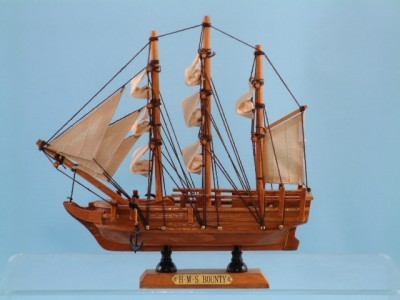 The wooden model of
the HMS Bounty shown here is not as accurate as it could be. The materials are
of low quality and it would retail for under $40.00 where other models on larger
scale, with accurate details and genuine fittings can range from a few hundred
dollars up to thousands of dollars.
The wooden model of
the HMS Bounty shown here is not as accurate as it could be. The materials are
of low quality and it would retail for under $40.00 where other models on larger
scale, with accurate details and genuine fittings can range from a few hundred
dollars up to thousands of dollars.
The HMS Bounty, also known as HM Armed Vessel Bounty, was a small merchant vessel purchased by the Royal Navy for a botanical mission. The ship was sent to the Pacific Ocean to acquire breadfruit plants and transport them to British possessions in the West Indies under the command of William Bligh. That mission was never completed, due to a mutiny led by the acting Master, Fletcher Christian. This was the famous Mutiny on the Bounty.
Bounty was originally known as collier Bethia, built in 1784 at the Blaydes shipyard in Hull. The vessel was purchased by the Royal Navy for £2,600 on 26 May 1787, refit, and renamed Bounty. The ship was relatively small at 215 tons, but had three masts and was full-rigged. After conversion for the breadfruit expedition, she was equipped with four 4-pounder (1.8 kg) cannons and ten swivel guns. Her dimensions were Length: 90 ft 10 in (27.69 m), Beam: 24 ft 4 in (7.42 m), Depth of hold: 11 ft 4 in (3.45 m), Sail plan: Full rigged ship.
William Bligh was appointed Commanding Lieutenant of Bounty on
16 August 1787, at the age of 33, after a career that included a tour as sailing
master of James Cook's Resolution during Cook's third and final voyage
(1776–1779).
Bligh described the ship thus (4.):
"The Burthen of the Ship was nearly 215 Tons; Her extreme length on deck 90Ft..10In. & breadth from outside to outside of the bends 24Ft..3 in. A Flush deck& a pretty Figure Head of a Woman in Riding habit; She mounted 4 four pounders& 10 Swivels & her
Complement was,
Lieut & Commander
2. Masters Mates 1. Gunners Mate
1. Master 2. Midshipmen 1. Carpenters
Mate
1. Boatswain 1. Clerk 1. Sailmaker
1. Gunner 2. Qr. Masters 1.
Armourer
1. Carpenter 1. Qr.Masr.Mate 1. Carpenters Crew
1. Surgeon 1.
Boatswains Mate 1. Corporal
24 Able Seamen
Total. 45 One of which is a
Widow's man. There was likewise a Botanist & his
Assistant."
 Although Captain Bligh
has been much maligned through the historical representations of him in film he
was considered one of the more lenient members of British Naval Officers.
Pictured at right from a 1814 'Portrait of Rear Admiral William Bligh' by
Alexander Huey, courtesy National Library of Australia, he had the patronage of
Sir Joseph Banks and allowed the crew to live ashore and care for the potted
breadfruit plants when they were in Tahiti, then called "Otaheite", where many
of these same men socialsed with the Tahitians. During the voyage out, Bligh
appointed Lieutenant Fletcher Christian, whom he had already sailed to Jamaica
with twice acting lieutenant. The HMS Bounty left Tahiti on April 4th 1789 laden
with 1015 breadfruits. On 28th of April 1789 a mutiny led by Christian occurred
when the ship was near Tonga. Of the then 42 men aboard only 22 joined
Lieutenant Christian in mutiny with 18 remaining loyal to Bligh, and joining him
in the ship’s boat. After a tumultuous time on Tubai , the 22 left for Tahiti
again where Christian married one of the Tahitian ladies, Maimiti, the daughter
of one of the local chiefs, on 16 June 1789.Christian settled with those who
remained with him by then on Pitcairn Island. It was here that a fellow
mutineer burned HMS Bounty.
Although Captain Bligh
has been much maligned through the historical representations of him in film he
was considered one of the more lenient members of British Naval Officers.
Pictured at right from a 1814 'Portrait of Rear Admiral William Bligh' by
Alexander Huey, courtesy National Library of Australia, he had the patronage of
Sir Joseph Banks and allowed the crew to live ashore and care for the potted
breadfruit plants when they were in Tahiti, then called "Otaheite", where many
of these same men socialsed with the Tahitians. During the voyage out, Bligh
appointed Lieutenant Fletcher Christian, whom he had already sailed to Jamaica
with twice acting lieutenant. The HMS Bounty left Tahiti on April 4th 1789 laden
with 1015 breadfruits. On 28th of April 1789 a mutiny led by Christian occurred
when the ship was near Tonga. Of the then 42 men aboard only 22 joined
Lieutenant Christian in mutiny with 18 remaining loyal to Bligh, and joining him
in the ship’s boat. After a tumultuous time on Tubai , the 22 left for Tahiti
again where Christian married one of the Tahitian ladies, Maimiti, the daughter
of one of the local chiefs, on 16 June 1789.Christian settled with those who
remained with him by then on Pitcairn Island. It was here that a fellow
mutineer burned HMS Bounty.
It was here, according to sole surviving mutineer found on that island, John Adams, that he died. Christian was survived by Maimiti and his son, Thursday October Christian (born 1790). Besides Thursday October, Fletcher Christian also had a younger son named Charles Christian (born 1792) and a daughter Mary Ann Christian (born 1793). Thursday and Charles are the ancestors of almost everybody with the surname Christian on Pitcairn and Norfolk Islands, as well as the many descendants who have moved to Australia, New Zealand and the United States. Rumours have persisted for more than two hundred years that Christian's murder may have been faked, that he had left the island and that he made his way back to England. Many scholars believe that the rumours of Christian returning to England helped to inspire Samuel Taylor Coleridge's The Rime of the Ancient Mariner (5.)
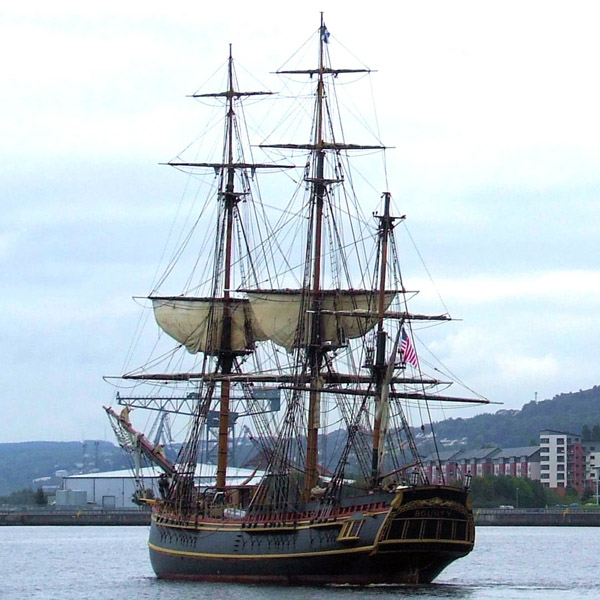 Luis
Marden, an American photographer, explorer, writer, filmmaker, diver, navigator,
and linguist who worked for National Geographic Magazine, discovered the remains
of Bounty in January 1957. After spotting remains of the rudder (which had been
found in 1933 by Parkin Christian, and is still displayed in the Fiji Museum in
Suva), he persuaded his editors and writers to let him dive off Pitcairn Island,
where the rudder had been found. Despite the warnings of one islander – "Man,
you gwen be dead as a hatchet!" – Marden dove for several days in the dangerous
swells near the island, and found the remains of the fabled ship: a rudder pin,
nails, a ships boat oarlock, fittings and a Bounty anchor that he raised. He
subsequently met with Marlon Brando to counsel him on his role as Fletcher
Christian in the 1962 film Mutiny on the Bounty. Later in life, Marden
wore cuff links made of nails from Bounty. Marden also dived on the wreck of HMS
Pandora and left a Bounty nail with HMS Pandora. Some of Bounty's
remains, such as the ballast stones, are still partially visible in the waters
of Bounty Bay.
Luis
Marden, an American photographer, explorer, writer, filmmaker, diver, navigator,
and linguist who worked for National Geographic Magazine, discovered the remains
of Bounty in January 1957. After spotting remains of the rudder (which had been
found in 1933 by Parkin Christian, and is still displayed in the Fiji Museum in
Suva), he persuaded his editors and writers to let him dive off Pitcairn Island,
where the rudder had been found. Despite the warnings of one islander – "Man,
you gwen be dead as a hatchet!" – Marden dove for several days in the dangerous
swells near the island, and found the remains of the fabled ship: a rudder pin,
nails, a ships boat oarlock, fittings and a Bounty anchor that he raised. He
subsequently met with Marlon Brando to counsel him on his role as Fletcher
Christian in the 1962 film Mutiny on the Bounty. Later in life, Marden
wore cuff links made of nails from Bounty. Marden also dived on the wreck of HMS
Pandora and left a Bounty nail with HMS Pandora. Some of Bounty's
remains, such as the ballast stones, are still partially visible in the waters
of Bounty Bay.
The last of the Bounty's 4-pounders was recovered in 1998 by an archaeological team from James Cook University and was sent to the Queensland Museum in Townsville to be stabilised through lengthy conservation treatment, i.e. nearly 40 months of electrolysis. The gun was subsequently returned to Pitcairn Island where it has been placed on display in a new community hall. (6)
HMS Pandora was a 24-gun Porcupine-class sixth-rate post ship of the Royal Navy launched in May 1779. She is best known as the ship sent in 1790 to search for the HMS Bounty and the mutineers who had taken her. She was wrecked on the return voyage in 1791.
In 1960 a replica was built for the film 'Mutiny on the Bounty' in which Marlon Brando appeared and was used thereafter as an educational sailing vessel. It is also the vessel seen in the recent Pirates of the Caribbean movies starring Johnny Depp.
On October 25, 2012, as residents of the U.S. east coast made frantic preparations for the arrival of Hurricane Sandy, the captain of the HMS Bounty-replica, Captain Robin Walbridge, to proceed with a scheduled voyage from New London, CT for St. Petersburg FL. A day and a half into this voyage the Bounty was less than 200 miles from the eye of the storm; the engine room started to flood, and the pumps were jammed with debris being torn off by the storm's 70 mph winds. The end came early next day, the Bounty was knocked down by a huge wave, tossing the captain and several crew members overboard. The Coast Guard rescued fourteen of the crew members, but Claudene Christian (an adventure-loving novice who had enlisted as crew a few months before and whose great-great-great-great-grandfather was Fletcher Christian) died. Captain Walbridge's body has not been found.
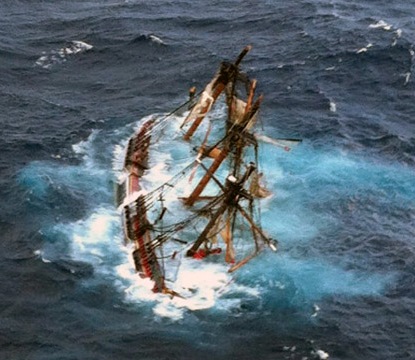 Right: HMS Bounty replica sinking during Hurricane Sandy. Photo: U.S.
Coast Guard
Right: HMS Bounty replica sinking during Hurricane Sandy. Photo: U.S.
Coast Guard
References:
1. Ship model. (2013, March 4). In Wikipedia, The Free
Encyclopedia. Retrieved from http://en.wikipedia.org/w/index.php?title=Ship_model&oldid=542091665
2. Admiralty Style model illustrating the frames of a ship: Wray Hodgson
Source: http://EzineArticles.com/7114590
3. Wooden
ship model. (2013, March 1). In Wikipedia, The Free Encyclopedia. Retrieved from
http://en.wikipedia.org/w/index.php?title=Wooden_ship_model&oldid=541375411
4. "Lt.Blighs account of the Bounty, William Bradley journal : A Voyage
to New South Wales, December 1786 - May 1792". The State Library of NSW.
Retrieved from http://acms.sl.nsw.gov.au/item/itemDetailPaged.aspx?itemID=420873
5. Fletcher Christian. (2013, April 1). In Wikipedia, The Free
Encyclopedia. Retrieved from http://en.wikipedia.org/w/index.php?title=Fletcher_Christian&oldid=548229250
6. HMS Bounty. (2013, March 31). In Wikipedia, The Free Encyclopedia.
Retrieved from http://en.wikipedia.org/w/index.php?title=HMS_Bounty&oldid=547911042
Photos:
Model ship from a tomb, Ancient Egypt, c. 2000 BCE. Dimensions: Height: 29.5 cm (11.6 in). Width: 67 cm (26.4 in). Depth: 15.5 cm (6.1 in). This work is part of the collections of the Louvre (Department of Egyptian Antiquities).
Admiralty Style model illustrating the frames of a ship by and courtesy of Perso.
HMS Bounty leaving Greenock on the River Clyde. *Photographer:* Inverclyde Views/Wikimedia Commons
|
|
Copyright Pittwater Online News, 2012. All Rights Reserved.